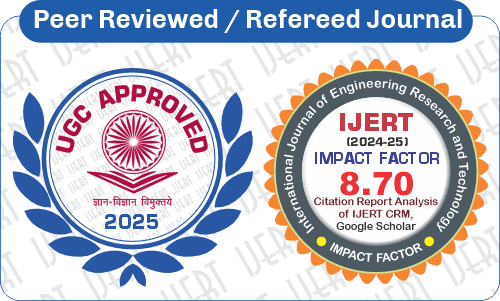 DOI : 10.17577/IJERTV14IS010048
DOI : 10.17577/IJERTV14IS010048
- Open Access

- Authors : Santhosh R. Menon
- Paper ID : IJERTV14IS010048
- Volume & Issue : Volume 14, Issue 1 (January 2025)
- Published (First Online): 06-02-2025
- ISSN (Online) : 2278-0181
- Publisher Name : IJERT
- License:
 This work is licensed under a Creative Commons Attribution 4.0 International License
This work is licensed under a Creative Commons Attribution 4.0 International License
Sustained Input – Differed Release Fed-Batch Biodigester
Santhosh R. Menon
Authorized Biogas Service Provider, Kerala State Sanitation Mission, India
Biogas Program Coordinator, National Service Scheme Industrial Training Institute, Govt. of Kerala, India
External Faculty, Green Energy Initiatives-Petroleum Conservation Research Association, Ministry of Petroleum, Govt. of India, National Award winner from National Institute of Rural Development & Panchayati Raj, Govt. of India [NIRDPR] and Indian Council of Agricultural Research [ICAR-IIST]
Abstract: Space-Style-Serviceability 3S Compatibility (3S) for any system, let alone bioreactors, is a matter of core concern. That what can be contained in minimal space, that what is stylish and that what is serviceable by oneself, alone find possibility in today's world. Olden days where radio used to be as big as a big basket is contained in a tiny mobile phone today. 3S model is sought all along this invention.
Key Words: 3S, biogas plant; organic matter; Brownian motion; biogas; sustained input; differed release, biorhythm;
-
INTRODUCTION
As a thumb rule, Digesters are usually designed as per the quantity of feed by and large. Various mechanisms are instituted so as to take down core aspects related to downsizing the overall system, sanitary conditions of biogas plant such as mosquito free, etc., speedy recovery of biogas from input feed, better chemical and biochemical parameters like BOD, COD etc., to name some. This paper intends to make an attempt to address certain core issues as stated supra.
Sustained Input – Sustained input, feeding here, allows delivery of a specific quantity of infusion at a programmed rate that leads to desired HRT (Hydraulic Retention Time). Such an approach of feed release is especially useful for inputs that requires to be metabolized/digested as per specifically designed system requirement. Simply speaking, sustained feed, by adjusting the speed of input feed, can keep the concentration of the overall digestate at more or less constant level within the digester. A constant infusion of feed within the digestion window is beneficial, for example, assimilation of liquor into human body. As a matter of fact, if a person gulps a specified quantity, say 180 ml of edible alcohol, at-a-single-stretch gulp, he gets intoxicated quickly and further damages his internal organs. On the contrary, if the same person takes the same quantity over a pretty long extended period of time within the same day, say a very small quantity, sip-by-sip, over 15-to-20 hours with excretion by way of sweat, urine and stool at regular intervals, then the level of intoxication will be considerably reduced compared
to at-a-single-stretch gulp. Further, his internal organs also will not be damaged. This is so, since the person in context is allowing enough timeframe for his body to digest the drink. Another classic example is that when a drug is dissolved in the aqueous body fluid, it can be easily transported with the fluid to the target receptors, here, the digestate as and such. Some studies have shown that one method to achieve sustained drug release is by preventing drug molecules from entering completely the aqueous environment for a manageable period of time. The infusion mechanisms of feed and their corresponding release rate can be designed as per desired matching models.
Differed Release – During anaerobic reaction, the organic matter gets consumed by microbes which results in decreased Chemical Oxygen Demand (COD) and thus, decreased pH value. Hence, so as to maintain a healthy pH within the system, necessary dilution of input feed as far close to +7.0 pH is a must. The best proposed way is to allow differed release of slurry or liquid output so as to maintain required pH value of the digestate. Further, the optimum pressure upon the digester also has to be maintained as naturally possible so as to obtain better biogas output.
Sustained Input-Differed Release [SIDR] Bioreactors, as the name suggests, leverages a combination of physical breakdown of input feed by crushing the input to a size not exceeding 600 micrometers followed by a chemical breakdown of input fees by means of aerobic hydrolysis for certain period of time, say 6-to-8 hours i.e. pre-treatment of organic feedstock like agricultural waste or food scraps by immersing in water in open air (exposing to oxygen) in the presence of aerobic bacteria followed by sustained release into the anaerobic column of the digester. This activity helps in breaking down complex organic polymers into simpler, more readily digestible molecules within the inlet column before being allowed to interact with anaerobic digestate present in the digester followed by removal of output (Slurry) at stipulated intervals so as to maintain required pH value for
the overall system. This way, the said system facilitates biogas production by means of increased methane yield, reduced HRT and improved digestate quality.
-
STUDY AREAS
Colony Forming Unit (CFU), here, is the number of microbes in a unit sample of digestate. The process of biogas production requires a large number of microorganisms, (bacteria), which are able to use the stored energy in carbohydrates, fats and proteins under anaerobic conditions for their metabolism. OLR is directly proportional to CFU. Thus, a consistent OLR for a consistent CFU at any given point of time followed by other consistent biochemical parameters work similarly, by and large as a thumb rule.
Effect of Hydraulic Retention Time (HRT), which basically is the travel time between inlet to outlet of feed, provides the length of digestion of the said feed. HRT, basically addresses the age of the input in the system, which otherwise is the time permitted for the bacteria to act on the input feed. However, it is to be noted that, from the quantified point of view, appropriate feed size and its concentration can proportionately address HRT. It is also to be noted that microbial issues obey Brownian motion which is better observed to the size-proportion of the input feed. While, it is accepted that HRT is the most important parameter due to its substrate uptake efficiency and its ability to determine the economics of anaerobic digestion, sustained release of feed along with pretreatment can efficiently tackle this issue. If the feed is of optimum size-proportion, then, a lower HRT can suffice the productive output in any digester while too low retention time will cause washout of the microbial population and too high a retention time will allow a scum layer build- up.
Solids Retention Time (SRT), that is, the average time that solids remain in the biogas reactor. Scientifically, higher the microbial concentration lower is the SRT since the microbes act on a large scale upon solids. Thus, SRT is inversely proportional to microbial concentration. For e.g., if the particle optimum size-proportion is low, say 10-to-20 m, i.e., if the feed is in a juicy format, say 600 m or less, then scum accumulation is observed to be directly proportional to feed size within a stipulated period of time. Thus, lesser the feed optimum size-proportion within a given concentration of microbes, lesser the required SRT.
Capillary Suction Time (CST) that is, the average time taken for water to be released from a given feed is, again, directly proportional to the optimum size-proportion of the feed. In Sustained Input bio-reactor systems, the CST is, by default,
optimally low since the particle size is less, say, not exceed 600 m. CST is proportional to sludge formation. Thus, any mechanismthat addresses CST is a direct reply to problems related to sludge formation.
Volatile Fatty Acid (VFA) are short-chain fatty acids that are produced during the middle stages of Anaerobic Digestion (AD). In biogas production, a smaller particle optimum size- proportion generally leads to higher volatile fatty acid (VFA) production due to increased surface area exposed to microbes and a healthy digester environment by regulating pH levels. Ideally a particle size ranging from 150-to-600m is ideal. For example, wheat powder is about 200m and a typically crushed food waste/leftovers has 600m while the particle size of cow dung is about 150m. As stated supra, sustained release of feed produces sustained release of VFA at any given point of time thereby contributing to the stability of concentration.
Organic Loading Rate (OLR) refers to the amount of organic material per unit reactor volume which is subjected to bio digestion in the reactor in a given unit time period. In a Sustained Feed Reactor, the OLR can be controlled as per requisite of the overall digester system as stated in the introduction dependent on the CFU status. Sustained release of feed materializes this parameter.
Oxidation-Reduction Potential (ORP), otherwise an inverse pH indicator, refers to electrical potential in a system needed to remove oxygen (deoxidization) of a given matter. Sustained feed relates to controlled minimal release of feed into the system. Hence the impact of OLR upon the system is minimal. Thus, the alkaline environment within the system remains undisturbed thereby maintaining a stable pH level and hence a stable, but lower ORP value. However, it is also to be noted that certain aerobic bacteria enhance biogas production by acting upon the input feed. Since micro- aeration i.e. addition of small amounts of oxygen to the digester optimizes the ORP, better biogas production results and specific benefits like H2S reduction can be observed. Adequate dilution and OLR, if maintained in consistency can tackle ORP effectively.
Biochemical Oxygen Demand (BOD) means a measure of the amount of biodegradable organic matter present in a given sample material. BOD gives a fair idea about the oxygen requirement to completely break the said sample down. A lower ORP value which means a higher pH value, generally indicates favorable conditions for methane-producing bacteria. Low BOD in slurry means efficient breakdown of organic matter during anaerobic digestion. Sustained release helps maintain better BOD since the feed size and quantity is
optimally minimal followed by a very slow rate of entry (OLR) to the main anaerobic digestate column.
Chemical Oxygen Demand (COD) represents the amount of organic matter available for the microbes to produce biogas. Since the effective OLR in the said system is minimal by virtue of its design, the corresponding microbial concentration acting upon proportionate feed is optimal. Microbial concentration inside the digester directly influences the biogas production activity, particularly the methanogens that generate methane. Sustained, or continuous, but adequately minimal feeding helps maintain better BOD
Mesophilic Anaerobic Digestion (MAD) refers to temperature conditions between 30°C to 40°C. These temperatures are ideal for the anaerobic bacteria that drive the digestion process, allowing them to thrive and maximize biogas production. Hence, the wind temperature and the format of material adopted for making a bioreactor is of importance.
-
DESIGN OF SIDR BIOREACTOR
It is important to feed the right content in the right pattern in the right time so as to maintain a consistent biorhythm in the digester.
While an ideal feeding volume (OLR) w.r.t. CFU for usual digester 1% volumetric weight, SFDR BIOREACTOR/Digester can withstand 2.5% OLR. This is so as to provide consistent BOD at any given point of time.
Smell of Slurry: -Heavy quantity feeding leads to high carbon dioxide formation. Here, the gas so formed may not burn /or/ sparsely lit. Slurry may smell like vinegar. Large size feed leads to high nitrogen formation. Here the slurry may smell like feces. The gas so formed may not burn. Poor/undesired feed leads to high Sulphur/ Undesired results. No gas may be formed followed by stagnation of the digester. Fecal smell results for slurry. Poor water content leads to poor microbial transaction resulting in acetylene smell while burning /or/ smell of decayed leaves in the slurry. Feeds containing spices may stagnate microbial activity resulting in fecal like smell in slurry. Non feeding for a prolonged time, say more than 3 months, may result in the slurry getting black in color due to stagnation of microbial activity and smell like open septic tank. Thus, it is important to pretreatment of input feed prior to engaging the feed into the system.
Colour of Slurry: – light green is best and denotes appropriate microbial activity. Dark green denotes heavy microbial activity. White colour denotes acetic acid built-up.
Yellow Colour denotes Sulphur built-up. Black colour denotes stagnation of microbial activity. Clear colour denotes sedimentation and death of the digestate.
Colour of Flame: – Indigo colour denotes best output of methane in biogas. Light blue denotes above average methane production. Pale blue colour denotes poor methane content often associated with poor nutrient feed. Yellow/Orange tinge denotes high carbon and low water content in feed. Red tinge in flame denotes poor combustion environment due to lack of oxygen mixing in biogas.
While an ideal feeding size for usual digester can go up to 30,000m, SIDR BIOREACTOR/Digester can be fed with input size not exceeding 600m. This is, so as to provide consistent microbe available VFA at any given point of time. While an ideal rate of feeding for usual digester can go up to 100% at a stretch, the rate of feeding for SIDR BIOREACTOR/Digester has to be perpetual followed by 75% perpetual release at any given point of time. This is, so as to provide consistent HRT at any given point of time. While an ideal dilution of feeding for usual digester can go up to 100% of organic wet matter (OWM), the dilution of feeding for SIDR BIOREACTOR/Digester has to be 150%.
This is, so as to provide stable pH for the digestate at any given point of time.
-
SIDR Digester
-
Feed Inlet pipe with perforated walls at bottom for sustainable release of input
-
Gas vent
-
Slurry Outlet Pipe
-
Pressure-relief valve (Optionally placed)
-
-
CONCLUSION
A simplified model of biogas digester that follows minimal, but sustained, size-proportion input followed by differed release of output is proposed herewith, designed for small and
medium utilities like homes and small farmers that suits pocket size, space, convenience to self-service and above all safety and sanitation, but not limited to. The said design allows minimal occupancy area and the gas vent may be connected to flexible gas bags / balloons. Such models take price & space down. Pretreatment may be embedded in the system followed by sustained release of input. A pressure relief valve so as to adjust differed release of slurry as desired according to the outputs is sought. Suitable Inoculum / catalysts and microbial enhancers may be used to upgrade the system
REFERENCES:
-
Self-studies conducted in various installations across the State of Kerala, Tamil Nadu & Karnataka, India
-
A critical review on operating parameters and strategies to improve the biogas yield from anaerobic digestion of organic fraction of municipal solid waste Sagarika Panigrahi, Brajesh K. Dubey, in Renewable Energy, 2019
-
Biomass Pretreatment for Enhancement of Biogas Production Written by Tamilarasan Karuppiah and Vimala Ebenezer Azariah



